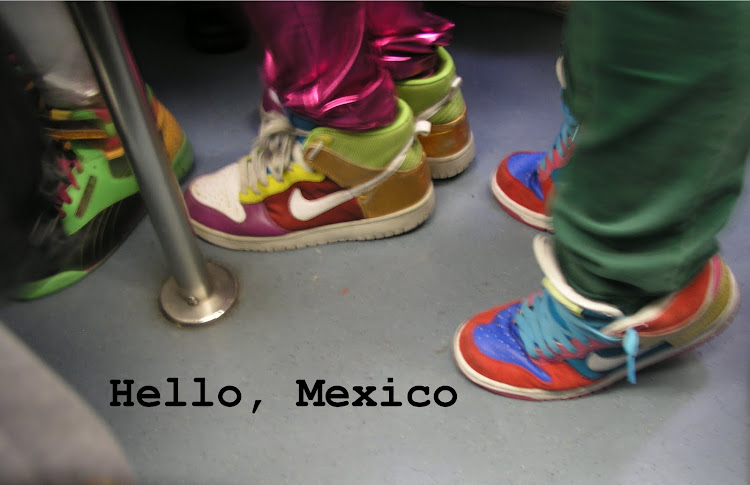In Mexico and in Mexican expat communities, November 1st and 2nd mark "Día de Muertos," or Day of the Dead. The two days are a chance for families to remember their lost ones, combining ancient Aztec, Mayan, Náhuatl, Purépecha and Totonocao traditions with Spanish Christianity. In the days prior, many Mexicans put up an altar in their house. Usually adorned with flowers (cempasúchil, or marigolds), a candle for and photo of each loved one, sugar or chocolate skulls, fruits, the sugary "bread of the dead" (pan de muerto), pumpkins, candied squash, religious symbols and paper decorations, the altar is said to be an offering for the departed.
On the first day of celebrations, families that have lost children will go to the graves where they are buried, clean and paint the site, bring toys and spend the night telling anecdotes and stories. Their spirits are said to return and be with them on the visit.
The second day commemorates adults who have passed away and the tradition is similar to that of children, but it is common to take to the grave typical Mexican drinks such as tequila, mezcal, pulque or atole.
What´s uniquely Mexican about these days is the attitude. Ancient indigenous views took a more natural view toward death: the spirit of the departed was determined more by the way the person died rather than their behavior during their time on earth. Death was an accepted, not feared, part of life. These perspectives, with infusions of Christianiaty, are present today, not only on Día de Muertos but in Mexican culture in general.
Día de Muertos traditions, which coincide with All Saints' and All Souls' days and have similar variants in Latin America, are especially prominent in southern and central Mexico. Each region has its respective adaptations, and the customs can vary from town to town. Even in the sprawling Mexico City metropolis, the tradition is strong.
The city held a mega-offering in its humongous Zócalo, or main plaza, for 10 consecutive years, but this week's offering was cancelled as the country is hit by an economic crisis. However, nearly all of the capital's 16 boroughs feature their own altar, and the National Autonomous University of Mexico, or UNAM, is dedicating a mega-offering to poet Edgar Allen Poe.
Día de Muertos has evolved over the years. When celebrated during pre-Hispanic times, human skulls were used. Now, sugar and chocolate skulls, or calaveras, have come to symbolize the celebrations, and Aguascalientes-native José Guadalupe Posada mocked the Mexican upper-class society with his etchings of the famous La Catrina in the early 1900s. The portraits, often featuring dancing and partying skeletons, along with satirical poems and prose mocking the living and describing personality traits, have been taken in as part of the celebrations over the years.
To the dismay of traditionalists, inevitable culture clashes have made the Mexican custom increasingly popular in the United States, while Halloween's presence is growing in Mexico. Costume parties, horror-movie marathons on cable and children dressed as Chucky trick-or-treating are becoming more and more common.
Día de Muertos, a rich, colorful, spiritual, religious, complex, humorous, heart-filled, sad, bittersweet, evolving and very Mexican tradition, is a unique blend of cultures, with a growing presence wherever the "muerte es parte de la vida" (death is a part of life) attitude is present.
02 November 2009
01 November 2009
Expat advice #2

Crowded pink line on a Sunday.
A new series on tips I've learned by experience after having lived in Mexico 2 years...many of them are just common sense to Mexicans, but not always to the folly-prone foreigner...
Expat advice #2:
Take escalators one step at a time
I often take the Metro to work. It's more strenuous then you might think: go up and down dozens of stairs, dodge crowds of people, cover your ears when acoustic terrorists (vendors with backpacks equipped with speakers who hawk pirated CDs and DVDs at 10 pesos a pop) assault your ears, try to withstand the stuffy, ventilation-free trains and avoid catching whiffs of urine, body odor, drying paint or buffet of unpleasant odors. The Metro, though, has its benefits: you get to point B relativey rápido barring any stalled trains, you´re not bound to the whims of traffic and it's cheaper than chicle, at two pesos a ride (like, USD $0.15)
Before I get more off-topic, never try to take the escalator steps too fast. It seems about half of the time when using Metro you are faced with non-functioning automatic stairs, but they are trickier than they seem. Taking two at a time puts more pressure on the stairs, seemingly sinking under your weight and force. I´ve stumbled up and down escalator stairs several times, and at my last rapid attempt I tripped up, leaving black skid marks on my hands and wrists and suprising fellow Metro riders: "Be careful, young man !!!"
Even functioning escalator stairs can get tough. Estimating your stepping distance plus the speed of the movemen of the stairs times the number of people competing to get to the top first times the number of minutes you are late to work takes a lot of brain power. Just watch out, and if you´re desperate, it's better to take the good'ole fashioned marble Metro stairs.
Wet stairs are another story.
posted
15:05
Subscribe to:
Posts (Atom)
